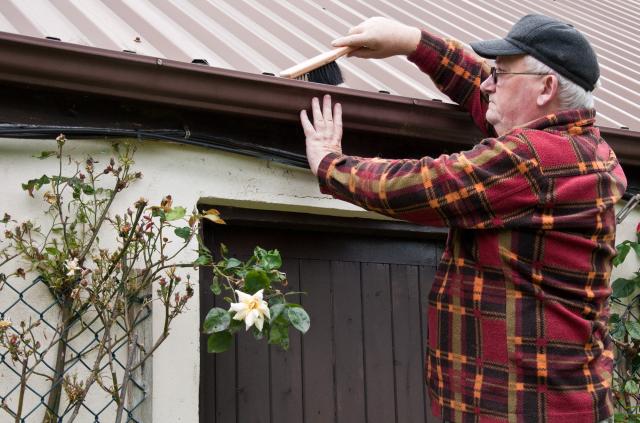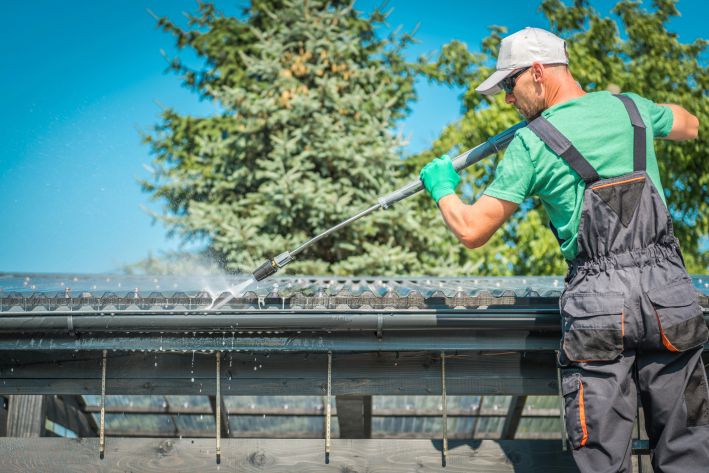
Tips for finding the best bathroom cabinets and vanities...
A bathroom has become more than a utilitarian space in the contemporary world. It turned into a p...

Gutter cleaning no longer requires dangerous ladder work or expensive professional services. Modern ground-based tools let you remove leaves, twigs, and debris while keeping your feet safely on solid ground. These ladder-free options make gutter maintenance accessible to homeowners of all ages and physical abilities. The four main types of DIY gutter cleaning tools include telescoping wands, extendable scoops, leaf blower attachments, and vacuum systems. Each option offers distinct advantages depending on your home's height, debris type, and cleaning preferences. Choosing the right gutter cleaning tool involves considering a few key factors and deciding which one to prioritize. Consider your home's specific debris challenges, physical requirements, and budget constraints before investing in any gutter cleaner. This assessment ensures you select equipment that delivers results without frustration. In this guide, we'll explore the best tools for gutter cleaning, whether you prefer staying on the ground or tackling it from the roof. You'll find practical recommendations tailored to different budgets, home sizes, and comfort levels with DIY work. From high-reach wands to powerful vacuum kits, we'll break down the pros, cons, and ideal use cases for each tool, so you can clean your gutters efficiently and safely.
With the right equipment, you can get leaves, twigs, and other buildups cleaned out of your gutters without having to climb dangerous heights or pay professionals. Whether your gutters are filled with soggy pine needles or dry fall leaves, there’s a tool designed to handle the mess efficiently. The current market for gutter cleaning tools offers solutions for any debris, from dry fallen leaves to soggy pine needles. Many of these systems hook right up to equipment you already own, such as a garden hose, a leaf blower, or a shop vacuum, all saving both time and money. From power washers to telescoping scoops, there are smart and effective options for every debris type and homeowner need.
Water-powered gutter cleaners connect directly to your garden hose or pressure washer, featuring telescoping poles that extend your reach up to 20–30 feet. These tools enable you to clean your gutters effectively without needing a ladder, making them ideal for single- and two-story homes.
High-quality systems include durable aluminum or fiberglass extension poles, ergonomic grips, and U-shaped nozzles that direct water flow along the gutter channel. Pressure washer-compatible models offer enhanced cleaning strength, capable of blasting away compacted debris, mud, and wet leaves.
Water-powered gutter cleaning tools are most effective when used on moderately clogged gutters or as part of a regular maintenance routine. They’re particularly useful in homes surrounded by deciduous trees, where frequent leaf buildup can occur. Most models are lightweight, easy to store, and quick to set up with standard hose fittings.
The cost of these simple-to-use gutter cleaners ranges from $30 to $100, depending on pressure compatibility and materials used.
|
Pros |
Cons |
|---|---|
|
Eliminates ladder use |
It can be messy on windy days |
|
Effective on wet leaves and moderate buildup |
Requires water pressure and a nearby source |
|
Covers long stretches quickly |
Less control over targeted cleaning |
Best for: Homeowners looking for a balance of convenience and power for regular gutter maintenance.
Basic hose-connected wands use your garden hose's water pressure to flush debris from gutters. These lightweight gutter cleaning tools often come with telescoping poles that extend 10–20 feet and feature curved, hook-style nozzles that fit easily over gutter edges.
Look for models with adjustable flow control valves at the base. This allows you to manage water output without having to return to the spigot. Some versions also offer pivoting heads or interchangeable spray tips to increase directional control and reach.
While not as powerful as pressure washer attachments, hose wands are easy to use and ideal for lighter cleaning jobs. They work best on dry or recently fallen leaves and are a great option for homeowners seeking a simple, low-effort solution for routine maintenance.
The cost of these gutter cleaners typically ranges from $20 to $50, making them both budget-friendly and beginner-friendly.
|
Pros |
Cons |
|---|---|
|
Easy to use and set up |
Limited cleaning power |
|
Lightweight and affordable |
May not dislodge compacted debris |
|
Gentle enough for older gutters |
Dependent on household water pressure |
Best for: Homeowners who need a low-cost tool for light to moderate gutter debris and prefer a simple, water-powered approach

Telescoping wands for pressure washers typically cost between $40 and $80.
Consider these factors when choosing a pressure washer gutter cleaner:
|
Pros |
Cons |
|---|---|
|
Effective on mud and grime |
Can create a mess below |
|
Works from ground level |
May splash during windy weather |
|
Adjustable water pressure |
Requires a water source nearby |
Best for: Homeowners dealing with compacted debris, mud, or heavy buildup in gutters
Manual gutter scoops attached to extendable poles offer precise control over debris removal. These tools feature lightweight aluminum or fiberglass poles that extend between 12–30 feet, topped with specially designed scoops.
Quality gutter scoop systems feature curved scoops that match the gutter profiles, flexible rubber ends that conform to various gutter shapes, and textured surfaces that effectively grip wet leaves. Many models feature quick-connect systems for easy attachment changes.
Unlike water-based systems, manual scoops let you see exactly what you're removing and work methodically through problem areas. They excel at removing heavier debris, such as pine needles or seed pods, that water might not flush away completely.
Basic extendable gutter scoops cost between $25 and $60, while premium options with cameras or specialized attachments can reach $100 or more. The physical effort required makes this approach more demanding than water-powered systems.
|
Pros |
Cons |
|---|---|
|
Precise debris control |
Requires more physical effort |
|
No water mess |
Takes longer than other methods |
|
Works on all debris |
May need frequent emptying |
Best for: Homeowners who want complete control over debris removal and don't mind the physical effort
Specialized gutter attachments can transform your existing leaf blower into an effective gutter cleaning tool. These curved tube extensions connect to most standard leaf blowers, redirecting airflow into gutters to blast away dry debris.
Most systems consist of multiple extension tubes that let you customize the length based on your home's height. The curved end piece features a flat nozzle design that concentrates airflow along the gutter channel.
This method works exceptionally well for dry leaves, pine needles, and small twigs. Work during dry weather when the debris is lightweight, starting at one end of the gutter and moving methodically along the length.
Leaf blower gutter attachments typically cost between $30 and $70 and can clean long stretches of gutter in minutes rather than hours. However, debris will scatter across your yard, requiring cleanup afterward.
|
Pros |
Cons |
|---|---|
|
Very fast cleaning |
Only works on dry debris |
|
Uses existing equipment |
Creates a yard mess |
|
Lightweight operation |
Less effective on wet materials |
Best for: Homes with primarily dry leaf debris and homeowners who prioritize speed over precision
Vacuum systems provide the cleanest debris removal option, combining suction power with extended reach to pull debris directly into collection containers. These gutter cleaning tools eliminate the mess associated with other cleaning methods.
Two main categories exist: wet/dry vacuum attachments that connect to standard shop vacuums, and dedicated gutter vacuum systems built specifically for this purpose. Attachment kits cost between $50 and $120, while dedicated systems range from $200 to $500.
Wet/dry vacuum attachments, which include curved wands with extension poles, remain limited by your vacuum's suction power and container capacity. Dedicated systems feature powerful motors, large collection containers, and specialized attachments that deliver superior performance for large homes or properties with extensive tree coverage.
The primary benefit is cleanliness—debris goes directly into a container rather than falling onto your lawn or patio. Many models include cameras or indicators to help verify that gutters are completely clean.
|
Pros |
Cons |
|---|---|
|
No mess below |
Higher upfront cost |
|
Complete debris removal |
May require frequent emptying |
|
Works on wet and dry debris |
Heavier than other options |
Best for: Homeowners who want mess-free cleaning and don't mind investing in specialized equipment
Consider your home's specific debris challenges, physical requirements, and budget constraints before investing in any gutter cleaner. This assessment ensures you select equipment that delivers results without frustration.
The type of debris in your gutters largely determines which cleaning tool will work best. Different materials require different removal approaches for maximum efficiency.
Dry leaves and small twigs work best with leaf blower attachments. These tools quickly blast away lightweight debris, making them ideal for homes surrounded by deciduous trees. Leaf blower gutter cleaners struggle with wet, compacted debris or heavier materials that resist air-based removal.
Pine needles and seed pods often interlock and form dense mats that resist air-based removal methods. Extendable pole scoops or vacuum systems prove more effective for these stubborn materials. The physical scraping action of scoops dislodges them, while vacuums provide powerful suction to extract them completely.
Mud, dirt, and decomposed debris require pressure washer gutter cleaners for superior results. The high-pressure water stream cuts through accumulated grime that other methods leave behind. Look for pressure washer attachments rated at 2000+ PSI with adjustable nozzle configurations.
Consider your property's vegetation carefully before selecting your tool. If you have multiple debris types throughout the year, investing in a combination of tools might be the most practical approach—a water-based system for spring cleaning, followed by a blower attachment for fall leaf removal.
Ground-based gutter cleaning tools vary considerably in their safety profiles and user-friendliness. The weight of the equipment becomes particularly important since you'll often hold it extended above your head.
Fiberglass poles typically offer the best weight-to-strength ratio, making them easier to maneuver for extended periods. Aluminum poles, while lightweight, may flex under pressure when fully extended, potentially reducing cleaning effectiveness.
Consider grip design and control mechanisms as well. Tools with cushioned grips and ergonomic handles reduce hand fatigue during lengthy cleaning sessions. For water-based systems, look for models with base-level flow control so you won't need to walk back and forth to adjust water pressure.
Your physical capabilities should influence your selection process. If you have limited arm strength or mobility issues, lightweight vacuum systems might be worth their premium price. Telescoping wands with counterbalance systems can significantly reduce the effective weight you need to support.
The height of your home represents another crucial factor. Single-story homes rarely require extensions beyond 12-15 feet, while two-story structures may need 20-30 feet of reach capabilities. Always choose a tool rated for at least 5 feet more than your estimated need to ensure adequate coverage without overextending.
Gutter cleaning tools range dramatically in price, primarily due to differences in materials, construction quality, and the features included. Understanding the relationship between upfront cost and long-term value helps make a sound investment.
Entry-level manual scoops with basic extension poles typically cost between $30 and $60 but may require replacement after 1-2 seasons of regular use. Mid-range options with reinforced connections and weather-resistant materials cost $60-$120 and generally last 3-5 years with proper care. Professional-grade systems with advanced features, such as cameras or rotating heads, cost $120-$300+ and often include warranties and availability of replacement parts.
For homes with extensive guttering or multiple properties, higher-end gutter cleaners often justify their cost through time savings and reduced physical strain. Smaller homes with easily accessible gutters might benefit most from simpler, more economical options.
Material quality significantly impacts longevity. Look for corrosion-resistant metals, UV-stabilized plastics, and sealed connections that prevent water intrusion. Tools with metal-to-metal connection points typically outperform plastic connectors, especially when fully extended under load.
The choice between ground-based and ladder-based gutter cleaners centers on safety above all else. Each year, approximately 164,000 emergency room visits result from ladder falls, with many occurring during home maintenance tasks like gutter cleaning. This reality has driven innovation in ground-based tools, though traditional ladder methods still serve specific purposes.
Understanding when to stay on solid ground versus when to climb makes the difference between safe, effective maintenance and potential injury.
Ground-based gutter cleaning eliminates the risk of falls entirely. Even experienced DIYers face unnecessary danger when working on ladders, especially around two-story homes or uneven terrain. Ground gutter cleaning tools make gutter maintenance accessible to homeowners of all ages and physical abilities.
Ground-based systems offer practical advantages beyond safety. You can move along gutters without having to climb down and reposition ladders, saving a significant amount of time. Many modern tools include cameras or curved designs that improve your view of gutter contents compared to looking down from a ladder.
These gutter cleaners work in weather conditions that would make ladder use dangerous. You can clean gutters during light rain or on windy days when ladder work becomes unsafe. The physical strain also decreases dramatically—climbing up and down ladders while carrying tools creates fatigue that can lead to mistakes.
Cost considerations favor ground approaches for most homeowners. Quality ground-based gutter cleaning tools cost between $50 and $300, while professional services typically run $150 to $350 per cleaning. The investment pays for itself after just one or two uses, especially for homes that require quarterly maintenance.
Certain situations still warrant traditional ladder approaches despite the advantages of ground-based systems. Homes with exceptionally tall rooflines beyond 30 feet often exceed the reach of standard telescoping tools. These cases require sectional ladders or professional services unless you invest in commercial-grade extension systems.
Precision work sometimes demands close-up access that only ladders provide. Identifying and repairing small gutter leaks, replacing gutter guards, or addressing downspout clogs might require direct hands-on interaction that ground tools cannot facilitate.
Heavily compacted materials or stubborn organic matter that has cemented into gutters may require manual scraping, as ground tools cannot provide sufficient pressure to accomplish this task. A basic extension ladder and gutter scoop can be acquired for under $150, making this approach more economical for one-time emergency cleaning needs.
The ideal approach often combines both methods—using ground-based tools for regular maintenance and reserving ladder work for annual inspections or repairs. This balanced strategy maximizes safety while ensuring your gutters receive thorough care.
Regular cleaning remains essential for preventing costly water damage and preserving your home's structural integrity, regardless of your chosen method. The key is to match your approach to your specific situation while prioritizing safety above all else.
Proper tool maintenance extends the lifespan of equipment and protects your investment. Quality gutter cleaning tools can last 3-5 years with regular care, but neglect can lead to premature replacement costs. Performing a few minutes of maintenance after each use helps prevent expensive repairs and ensures reliable performance.
Always rinse your gutter cleaner tools thoroughly after each use. Dried debris hardens over time, making future cleaning more difficult and potentially damaging delicate components. For telescoping poles, extend them fully before cleaning to remove hidden dirt from internal sections.
Never store wet tools. Moisture trapped inside telescoping mechanisms causes corrosion that weakens connections and leads to failure. Damp storage environments accelerate rust formation on metal parts. Dry all components completely using a clean cloth before storage.
Store your gutter cleaner tools in a climate-controlled space when possible. Extreme temperature fluctuations can cause plastic components to warp and compromise their structural integrity. Hang extension poles horizontally rather than leaning them vertically to prevent bending.
Apply a light coat of silicone spray to metal connections for seasonal storage. This simple step prevents seized joints when you retrieve the tool months later.
Hose attachments require specific attention to prevent leaks and maintain pressure. Check rubber gaskets and O-rings regularly for cracks or compression. Replace these inexpensive parts at the first sign of wear to prevent water damage to internal components.
Pressure washer gutter cleaner attachments require regular removal of mineral deposits. Soak nozzles in vinegar overnight to dissolve these deposits without harsh chemicals. Inspect high-pressure connections for hairline cracks that could indicate imminent failure.
Vacuum systems need consistent filter maintenance. Empty collection bags after each use and inspect internal filters monthly. Clogged filters reduce suction power and strain motors. Replace filters according to manufacturer recommendations—this costs far less than repairing burned-out motors.
Keep a maintenance log noting when you clean, store, and replace components. This helps track when parts need replacement and ensures you don't skip important maintenance steps.
Ground-based gutter cleaning tools eliminate the safety risks and physical demands associated with traditional ladder work while delivering professional-quality results. Water-powered wands excel at removing mud and compacted debris. Manual scoops provide precise control over stubborn materials. Leaf blower attachments quickly clear dry leaves and vacuum systems offer mess-free cleaning.
Your home's specific needs should determine which tool works best. Consider your gutter height, surrounding vegetation, and physical capabilities before making a purchase. Matching the right tool to your debris type makes the difference between efficient maintenance and frustrating, incomplete cleaning.
Safety remains the primary benefit of ground-based tools. These systems eliminate ladder-related injuries while achieving results comparable to professional services. Most tools pay for themselves after just a few uses, especially for homes requiring seasonal maintenance.
Key factors to consider when choosing your gutter cleaning tool:
GET THE ESSENCE OF RELEVANT HOME
IMPROVEMENT TOPICS IN LESS THAN 5 MINUTES

Tips for finding the best bathroom cabinets and vanities...
A bathroom has become more than a utilitarian space in the contemporary world. It turned into a p...

Bathroom walls face tougher conditions than any other room in your home. Steam from hot showers,...

Thanks for joining our homeowners’ community.
Stay tuned!
Choose the category
Choose the category